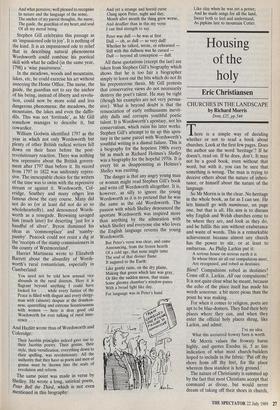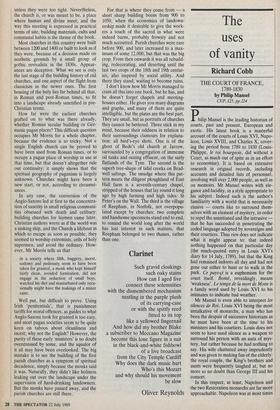Housing of the holy
Eric Christiansen
CHURCHES IN THE LANDSCAPE by Richard Morris
Dent, £25, pp.544
There is a simple way of deciding whether or not to read a book about churches. Look at the first few pages. Does the author use the word `heritage'? If he doesn't, read on. If he does, don't. It may not be a good book, even without that word, but with it, you can be sure that something is wrong. The man is trying to deceive others about the nature of inheri- tance, or himself about the nature of the language.
So Mr Morris is in the clear. No heritage in the whole book, as far as I can see. He lets himself go with numinous, on page one, but that is all. His aim is to discuss why English and Welsh churches come to be where they are, and look as they do, and he fulfils this aim without exuberance and waste of words. This is a remarkable achievement because almost any church has the power to stir, or at least to embarrass. As Philip Larkin put it:
A serious house on serious earth it is In whose blent air all our compulsions meet, Are recognised, and robed as destinies.
Blent? Compulsions robed as destinies? Come off it, Larkin. All our compulsions? It is not quite clear what he meant, because the echo of the place itself has made his words sonorous: a bit more pious than the point he was making.
For when it comes to religion, poets are apt to be blue-domers. They find their holy places where they can, and when they enter the official holy places shrug, like Larkin, and admit: I've no idea
What this accoutred frowsty barn is worth.
Mr Morris values the frowsty barns highly, and quotes Exodus iii, 5 as fair indication of what most church-builders hoped to include in the fabric: 'Put off thy shoes from off thy feet, for the place whereon thou standest is holy ground.'
The nature of Christianity is summed up by the fact that most Christians accept that command as divine, but would never dream of taking off their shoes in church, unless they were too tight. Nevertheless, the church is, or was meant to be, a place where human and divine meet; and the way this meeting is expressed in practical terms of site, building materials, cults and communal habits is the theme of the book.
Most churches in this country were built between 1200 and 1400 or built to look as if they were, because of a decision made on aesthetic grounds by a small group of gothic revivalists in the 1830s. Appear- ances are deceptive. What we see is only the last stage of the building history of old churches, and one aspect of the flight from classicism in the newer ones. The first housing of the holy lies far behind all that, in Roman and post-Roman times, to fit into a landscape already sanctified in pre- Christian terms.
How far were the earliest churches grafted on to what was there already, whether Roman secular building or Ger- manic pagan places? This difficult question occupies Mr Morris for a whole chapter, because the evidence is so tricky. Not a single English church can be proved to have been used from Roman times, or to occupy a pagan place of worship in use at that time, but that doesn't altogether rule out continuity; it simply shows that the spiritual geography of paganism is largely unknown. Churches might have been a new start, or not, according to circumst- ances.
In any case, the conversion of the Anglo-Saxons led at first to the concentra- tion of sanctity in small religious communi- ties obsessed with death and celibacy: building churches for laymen came later. Christian authors wrote as if the world was a sinking ship, and the Church a lifeboat in which to escape as soon as possible; they seemed to worship extremists, cells of holy supermen, and avoid the ordinary. How- ever, Mr Morris tells us that in a society where filth, buggery, incest, sodomy and pederasty seem to have been taken for granted, a monk who kept himself fairly clean, avoided fornication, did not engage in the seduction of small boys, watched his diet and masturbated only occa- sionally might have the makings of a minor saint.
Well put, but difficult to prove. Using Irish `penitentials', that is punishment tariffs for moral offences, as guides to what Anglo-Saxons took for granted is too easy, and most pagan societies seem to be quite keen on taboos about cleanliness and incest; why not the English? However, the purity of these early 'ministers' is no doubt overstressed by some, and the squalor of it all may have been overlooked. The big mistake is to see the building of the first parish churches as a symptom of spiritual decadence, simply because the monks said it was. Naturally, they didn't like holiness leaking out over the landscape under the supervision of hard-drinking landowners. But the monks have passed away, and the parish churches are still there. For that is where they come from — a short sharp building boom from 900 to 1050, when the economics of landown- ership made it desirable to give the work- ers a touch of the sacred in what were indeed barns, probably frowsty and not much accoutred. Parish churches were rare before 900, and later increased to a max- imum of some 12,000; but that was the big crop. From then onwards it was all rebuild- ing, redecorating, and deserting until the last two crops of the 18th and 19th centur- ies, also inspired by social utility. And there they stand, waiting to become ruins.
I don't know how Mr Morris managed to cram all this into one book, but he has, and he doesn't forget chapels and meeting- houses either. He gives you many diagrams and graphs, and many of them are quite intelligible, but the plates are the best part. They are small, but as portraits of churches they cannot be bettered. Three stick in my mind, because their oddness in relation to their surroundings clamours for explana- tion: all bird's-eye shots. One is of the ghost of Bede's old church at Jarrow, surrounded by a congregation of immense oil tanks and oozing effluent, on the surly flatlands of the Tyne. The second is the superb tree-shape of tidal creeks on Brad- well saltings. The smudge where this pat- tern meets the diligent ploughland of East Hall farm is a seventh-century chapel, stripped of the houses that lay round it long ago by high farming and high tides: St Peter's on the Wall. The third is the village of Reepham, in Norfolk, not overpopu- lated except by churches: two complete and handsome specimens stand end to end, to remind the world long after the world has lost interest in such matters, that Reepham belonged to two thanes, rather than one



















































 Previous page
Previous page